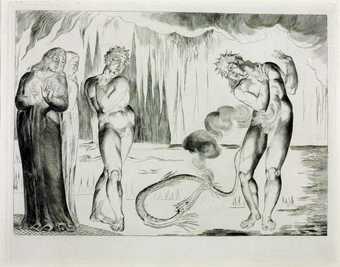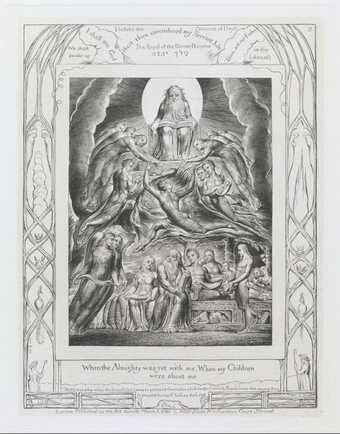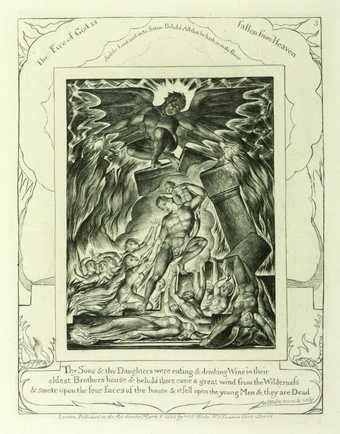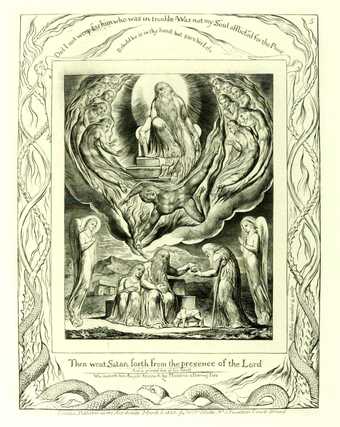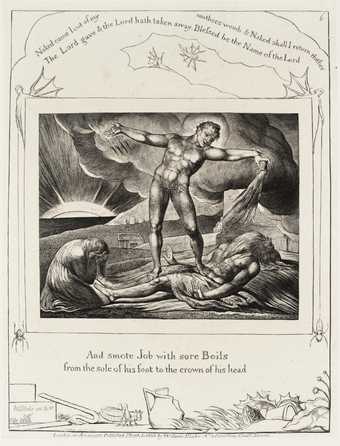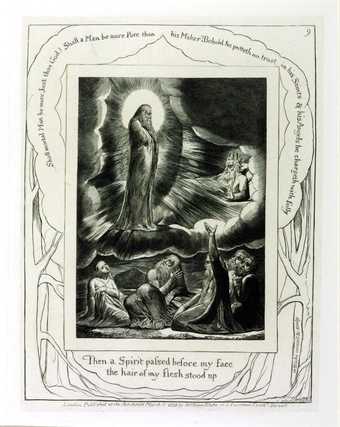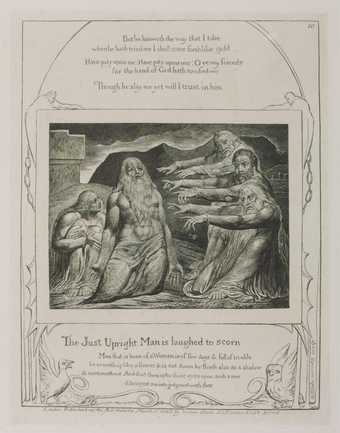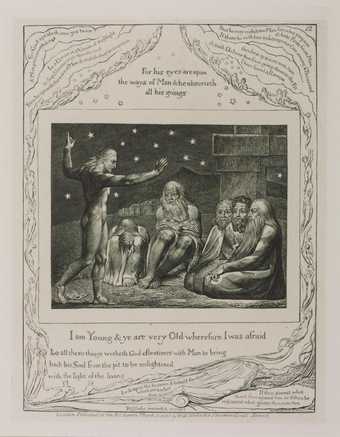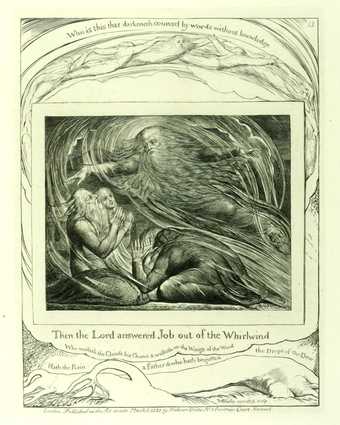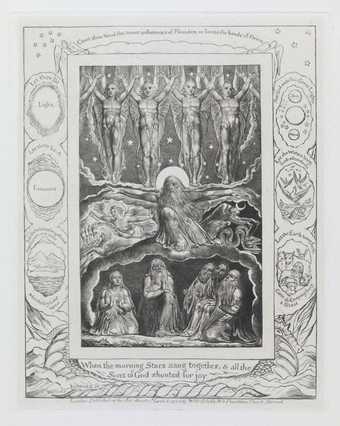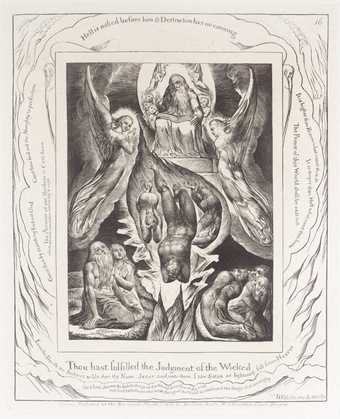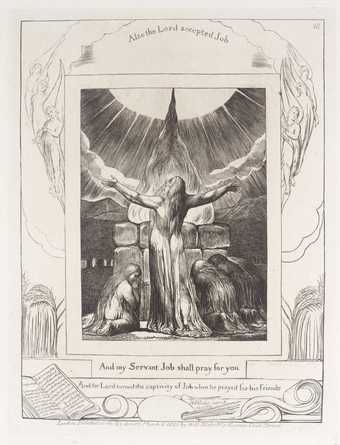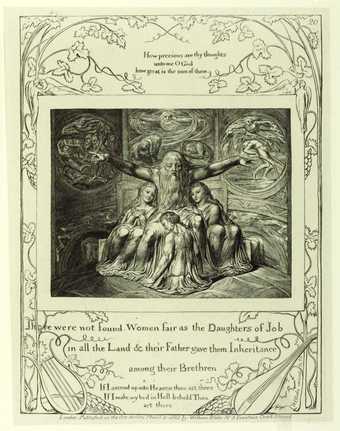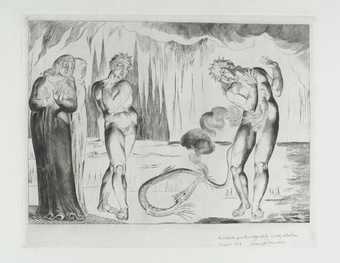
In Tate Britain
Prints and Drawings Room
View by appointment- Artist
- William Blake 1757–1827
- Medium
- Line engraving on paper
- Dimensions
- Image: 197 × 152 mm
- Collection
- Tate
- Acquisition
- Purchased with the assistance of a special grant from the National Gallery and donations from the Art Fund, Lord Duveen and others, and presented through the Art Fund 1919
- Reference
- A00022
Display caption
Blake adapts as his main title words from verse 14 of chapter 7 of the Book of Job: 'Then thou scarest me with dreams, and terrifiest me through visions'. The substance of Job's dreams is not described in chapter 7. However, Blake derives some of his imagery and his quotations in the margins from elsewhere in the Bible. Thus 'my skin is black upon me and my bones are burned with heat' comes from the Book of Job, chapter 30. Satan, seen here hovering over Job, is described in the second book of Corinthians as 'transformed into an Angel of Light.' The flames of Hell which rise up from beneath Job's bed are echoed in the marginal design.
Gallery label, August 1993
Does this text contain inaccurate information or language that you feel we should improve or change? We would like to hear from you.
Catalogue entry
A00022 [from] Illustrations to The Book of Job: Engravings
1823–6/1874 [A00012-A00032; T05845; complete]
A 00012–32 /-
Twenty-two line engravings on india paper laid on drawing paper approx. 510×345 (20×13 1/2)
Purchased with the assistance of a special grant from the National Gallery and donations from the National Art-Collections Fund, Lord Duveen and others, and presented through the National Art-Collections Fund 1919
PROVENANCE John Linnell; his heirs, sold Christie's 15 March 1918 (183) £33.12.0.bt Martin for the donors
LITERATURE Gilchrist 1863, 1, pp.283–4, 297; Wicksteed 1910 and 1924; Russell Engravings 1912, 102–15 no.33: Keynes Bibliography 1921, pp.179–82 no.55: Binyon and Keynes 1935, series repr. vol.VI; Keynes Engravings 1950, pp.16–17, series repr.pls. 42–68; Keynes Writings 1957, pp.869–70, 872, 874, 876–7; S. Foster Damon, Blake's Job 1966, series repr.; Bentley Blake Records 1969, pp.234 n.i, 277–397 passim, 586–605; Andrew Wright Blake's Job: A Commentary 1972, series repr.; Lindberg 1973, pp.24–32, 40–52, 167–76, 183–352 nos.0A–21A, series repr.; Bentley Blake Books 1977, pp.517–24 no.421; Bindman Graphic Works 1978, pp.486–7 nos.625–46, series repr.; Mitchell 1978, pp.41–2; Essick Printmaker 1981, pp.92, 105, 220, 234–50, 252; Robert N. Essick, ‘Blake's Engravings to the Book of Job; An Essay on their Graphic Form with a Catalogue of their States and Printings’ in David Bindman, ed., William Blake's Illustrations of the Book of Job 1987, pp.35–101.
John Linnell, who had commissioned the second set of watercolour illustrations to the Book of Job in 1821, entered into a formal agreement with Blake for the engravings on 25 March 1823: Linnell was to pay Blake £5 a plate or £100 for the set, and in addition he agreed to give Blake an extra £100 if the profits of the work made this possible. The agreement was for twenty engravings though in the event twenty-one subjects were engraved together with a title-page. On 5 March 1825 Linnell went with Blake to the printer J. Lahee to see proofs being taken. The series is dated 8 March 1825 but the final engravings do not seem actually to have been ready until the end of March 1826 (Bentley 1969, pp.277, 300 and 327). At this time 215 sets of engravings marked ‘Proof’ were issued; these should be distinguished from the working proofs, on some of which Blake tried out designs for the borders. The word ‘Proof’ was then deleted (traces can be seen on A00013) and a further 100 sets were printed on drawing paper. According to John Linnell Jr, writing to Bernard Quaritch on 6 May 1892, Linnell, after the 1826 printing, ‘put the plates away, & they were never again used after this time until the year 1874. At this time my father...had one hundred copies printed from the plates upon India paper’. Although the distinctive cover is now missing, it seems that the Tate Gallery's copies of the engravings are from this 1874 printing. The original plates were given by Herbert Linnell to the British Museum Print Room on 28 May 1919.
Each engraving is inscribed ‘W Blake inv. & sculp’. In addition each is inscribed in the lower margin with variations of the text ‘London. Published as the Act directs March 8:1825 by William Blake No3 Fountain Court Strand’; the first actual design (A00012) is mistakenly dated with the year 1828 and ‘Willm’ is sometimes substituted for ‘William’, while the punctuation is also slightly varied.
More importantly, the borders of each design bear a number of inscriptions taken from the Bible or with variations of biblical texts. These add a verbal gloss to the designs which in themselves embody Blake's critical reaction to the original story as set out in the Old Testament. The fullest analysis is in Lindberg though Wicksteed, Damon 1966 and Wright also contain full commentaries. Blake's interpretation of his text is only given in summary form in this catalogue.
These engravings were formerly inventoried as nos.3372 i–xxii. The new inventory numbers omit the title-page.
A00022 Job's Evil Dreams
Line engraving 197×152 (7 3/4×6); platemark 217×170 (8 9/16×6 13/16)
Inscribed ‘WBlake invenit & sculp’ b.l., ‘London. Published as the Act directs March 8: 1825 by Willm Blake No3 Fountain Court Strand’ below, ‘11’ t.r., and with texts given below
Illustration no.11: Job, vii, 13–15, the source of Blake's main title, ‘With Dreams upon my bed thou scarest me & affrightest me/with Visions’. At this point in the book the nature of Job's dreams and visions are not stated but Blake took some of his imagery, and his other quotations, from later in the book and elsewhere in the Bible: ‘Why do you persecute me as God & are not satisfied with my flesh. Oh that my words/were printed in a Book that they were graven with an iron pen & lead in the rock for ever/For I know that my Redeemer liveth & that he shall stand in the latter days upon/the Earth & after my skin destroy thou This body yet in my flesh shall I see God/whom I shall see for Myself and mine eyes shall behold & not Another tho consumed be my wrought Image’ (Job, xix, 22–7), and ‘Who opposeth & exalteth himself above all that is called God or is Worshipped’ (II Thessalonians, ii, 4); ‘My bones are pierced in me in the/night season & my sinews/take no rest’ (Job, xxx, 17); ‘My skin is black upon me/& my bones are burned/with heat’ (Job, xxx, 30); ‘The triumphing of the wicked/is short, the joy of the hypocrite is/but for a moment’ (Job, xx, 5); ‘Satan himself is transformed into an Angel of Light & his Ministers into Ministers of Righteousness’ (II Corinthians, xi, 14–15).
This design is a turning-point of the series, which perhaps explains why it falls out of sequence as an illustration to the Book of Job. Traditionally Job's dreams were identified with a vision of Hell but Blake expands this by making the flames and demons of hell, shown below, dependent upon the Tables of the Law above, the two being linked by the outstretched arms of the figure that hovers over Job; this figure is developed from the God of the second design (A00013) but is shown entwined by a serpent and with a cloven hoof: Job's God has become Satan. In recognizing that his idea of God is in fact Satan Job, in the depths of his despair, is now capable of spiritual salvation. This possibility is embodied in a number of the quotations inscribed by Blake, particularly ‘For I know that my Redeemer liveth’, which alludes, of course, to the God of the New Testament.
Published in:
Martin Butlin, William Blake 1757-1827, Tate Gallery Collections, V, London 1990
Explore
- emotions, concepts and ideas(16,416)
-
- emotions and human qualities(5,345)
-
- suffering(161)
- actions: postures and motions(9,111)
-
- lying down(392)
- sleeping(315)
- man(10,453)
- dreaming(213)
- Job(24)
- Job, chapter 19(2)
- Job, chapter 20(1)
- Job, chapter 30(2)
- Job, chapter 7(2)
- vision(678)
- inscriptions(6,664)
-
- caption(358)
- printed text(1,138)
- quotation(297)
You might like
-
William Blake The Serpent Attacking Buoso Donati
1826–7, reprinted 1892 -
William Blake Satan before the Throne of God
1825, reprinted 1874 -
William Blake Job’s Sons and Daughters Overwhelmed by Satan
1825, reprinted 1874 -
William Blake Satan Going Forth from the Presence of the Lord, and Job’s Charity
1825, reprinted 1874 -
William Blake Satan Smiting Job with Sore Boils
1825, reprinted 1874 -
William Blake The Vision of Eliphaz
1825, reprinted 1874 -
William Blake Job Rebuked by his Friends
1825, reprinted 1874 -
William Blake The Wrath of Elihu
1825, reprinted 1874 -
William Blake The Lord Answering Job out of the Whirlwind
1825, reprinted 1874 -
William Blake When the Morning Stars Sang Together
1825, reprinted 1874 -
William Blake Behemoth and Leviathan
1825, reprinted 1874 -
William Blake The Fall of Satan
1825, reprinted 1874 -
William Blake Job’s Sacrifice
1825, reprinted 1874 -
William Blake Job and his Daughters
1825, reprinted 1874 -
William Blake The Serpent Attacking Buoso Donati
1826–7, reprinted 1968

